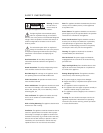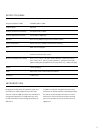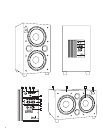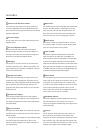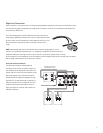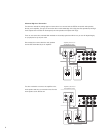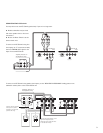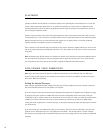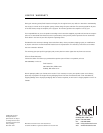
10
PLACEMENT
Typically the ICS Sub 24 will produce the smoothest response when placed against a wall. Placement in a corner will
further enhance bass output allowing you to run operate the subwoofer at a lower power level. Experiment with
subwoofer placement while at the same time adjusting crossover frequency, output level, and phase. (See section on
Fine-Tuning Your Subwoofer below.)
Choose a musical selection with a heavy and continuous bass line. Play a short section several times until you have a
firm impression of it in your mind. Then try another location to see if it provides smoother or more balanced response .
Repeat this process until you are content with the bass response you are getting. Strive for a smooth, solid bass
response that does not emphasize any part of the bass range.
Once a location for the subwoofer has been selected, you may want to attach the supplied cabinet feet. There are two
side of the cabinet that have pre-drilled pilot holes for the feet. This enables you to use either a vertical or horizontal
orientation.
Note: Avoid placing the ICS Sub 24 close to a television or monitor. There should be at least 8 inches (20cm) between
the two components. If getting the best sound, together with the physical constrains of the room, require that the
two units must be closer than that you can purchase a magnetic shielding kit from Snell Acoustics.
FINE-TUNING YOUR SUBWOOFER
Note: If you are connecting the ICS Sub 24 to a THX receiver/controller, use the THX input. (See the “THX Input”
section on page 6.) This bypasses all the crossover circuits and level controls in the amplifier. All audio controlling is
done by the THX receiver/controller.
Setting the Internal Crossover
When using the standard Low Inputs or High Level inputs you will need to adjust the internal crossover to make the
ICS Sub 24 sonically blend with the main speaker in the system.
If you are using line-level inputs and returning the high-pass filtered signal to the amplifier (see the diagram on page
6), begin by setting the crossover at 100Hz. Some rooms naturally overemphasize bass in this region, creating an
undesirable ”bump“ or ”boomy“ quality in the sound. If this is the case with your room, try turning the crossover down
to 80Hz. On the other hand‚ some rooms have a natural tendency to ”swallow up“ the bass in the 100Hz region,
causing the sound to appear thin. In rooms of this type, try setting the crossover at 125Hz. This may help to round out
the overall sound.
If you are running your main speakers full range, set the crossover close to the bass cut-off frequency of your main
speakers. See the specifications for your main speakers for information. This will help achieve a smooth, seamless
blend between your speakers and the subwoofer. Experiment until you are happy with the main speaker-to-subwoofer
transition.




